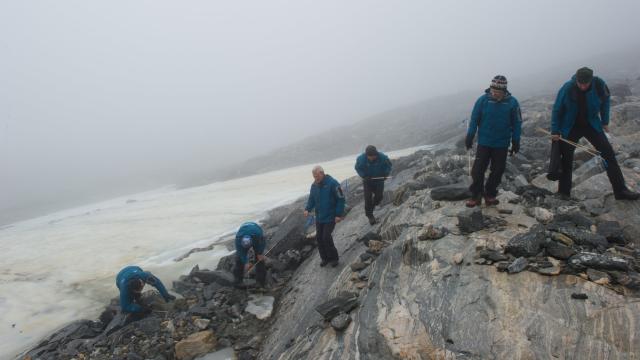Archaeologists in central Norway have uncovered evidence of a heavily travelled mountain passageway that was used during the Viking Age. Hundreds of beautifully preserved items were found atop a melting glacier, in a discovery that was, sadly, made possible by global warming.
New research published today in Antiquity describes a forgotten mountain pass at Lendbreen, Norway, that was in use from the Iron Age through to the European medieval period.
Located on Lomseggen Ridge, the passageway is absolutely littered with well-preserved artifacts, including mittens, shoes, horse snowshoes, bits of sleds, and even the remains of a dog still attached to its collar and leash. Radiocarbon dating of these artifacts is painting a picture of how and when this pivotal mountain pass was used, and its importance to both local and outside communities.
The hundreds of items found at Lendbreen were either dropped accidentally or intentionally as people made their way across the mountain. These items, some made from organic materials, became locked in glacial ice, preserving a record of use that spans 1,200 years. The passageway was discovered in 2011, and fieldwork has continued since then as the glacier continues to retreat and expose more items.
“Global warming is leading to the melting of mountain ice worldwide, and the finds melting out of the ice are a result of this,” Lars Pilø, the first author of the study and a co-director of Norway’s Glacier Archaeology Program, told Gizmodo. “Trying to save the remains of a melting world is a very exciting job—the finds are just an archaeologist’s dream—but at the same time, it is also a job you cannot do without a deep sense of foreboding.”
Local people used the mountain pass to travel back and forth from their summer homes, but it was also used by long-distance travellers and traders, according to the new research. The path measures just 700 meters long (2,300 feet), reaching a maximum height of 1,920 meters (16,300 feet) along the Lomseggen Ridge at Lendbreen.
Sifting through the melting glacier, the archaeologists found horse snowshoes, the buried remains of packhorses and their associated dung piles, parts of sleds, a walking stick adorned with a runic inscription, a knife with well-preserved wooden handle, and a wood distaff used to hold wool during hand-spinning.
Other items included mittens, shoes, and the remains of clothing, including an Iron Age tunic. Some items defied description, with no archaeological analogs.
“These finds tell us a rich history of the local farming community of which there are otherwise only meager sources,” said Pilø.
The high number of cairns in the pass—piles of stones meant to assist with navigation—and even a shelter, “points to the need to mark the route for non-locals,” he said, which the team took as evidence of long-distance travel. Other evidence, such as reindeer antlers and pelts, point to trade outside of Norway, while the remains of dairy residues inside pots and leaf fodder were taken as evidence of local travel.
Interestingly, and perhaps counterintuitively, the pass was likely used during the late winter and spring. That’s because the route only really works for horses when the rough ground is covered in snow. Pilø said his team found an exquisitely preserved horse snowshoe sticking out of the ice in the pass during the 2019 melt, “which backs this hypothesis up nicely.” To which he added: “The amount of snow cover varies a lot from year to year, so the route may sometimes have been possible to use for larger parts of the year.”
Radiocarbon dating was used to date 60 of the recovered items, allowing the researchers to determine when the path was used and pinpoint times of intense traffic. The first evidence of the passageway dates back to 300 CE during the Roman Iron Age, when local settlements were on the rise. Traffic along the path peaked around 1000 CE during the Viking Age—a time of increased mobility, political centralization, increased trade, and greater urbanism in northern Europe.
[referenced url=” thumb=” title=” excerpt=”]
By around 1500 CE, however, the passageway was abandoned and eventually forgotten. Multiple factors were cited as possible reasons for this, including climate change, economic shifts, and medieval pandemics, namely the Black Death, which peaked in Europe from 1347 to 1351.
Global warming made this discovery possible, but don’t kid yourself into thinking this is good for archaeology. In 2017, researchers warned that rising sea levels could threaten around 32,000 prehistoric and historic archaeological sites in North America.
